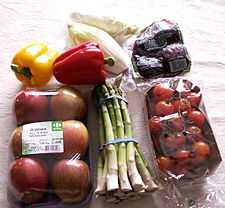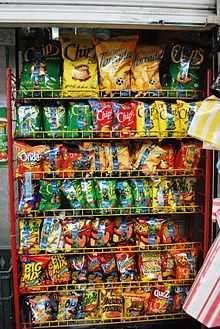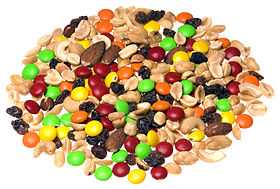Snack food
| Part of a series on |
| Meals |
|---|
 |
| Common meals |
| Components and courses |
| Related concepts |
A snack is a portion of food often smaller than a regular meal, generally eaten between meals.[1] Snacks come in a variety of forms including packaged and processed foods and items made from fresh ingredients at home.
Traditionally, snacks were prepared from ingredients commonly available in the home. Often leftovers, cold cuts sandwiches, nuts, fruit, and the like were used as snacks. The Dagwood sandwich was originally the humorous result of a cartoon character's desire for large snacks. Beverages, such as coffee, are not generally considered snacks though they may be consumed along with snack foods. A beverage may be considered a snack if it possesses a substantive food item (e.g., strawberries, bananas, kiwis) that has been blended to create a smoothie.
Plain snacks like plain cereals, pasta and vegetables are also mildly popular, and the word snack has often been used to refer to a larger meal involving cooked or leftover items. Six-meal eating is a form of eating that interjects healthy snacks in between small meals, to stave off hunger and promote weight loss.
With the spread of convenience stores, packaged snack foods are now a significant business. Snack foods are typically designed to be portable, quick and satisfying. Processed snack foods are designed to be less perishable, more durable, and more portable than prepared foods. They often contain substantial amounts of sweeteners, preservatives, and appealing ingredients such as chocolate, peanuts, and specially-designed flavors (such as flavored potato chips). A snack eaten shortly before going to bed or during the night may be called a midnight snack.
Nutritional concerns
Snack foods are often subjectively classified as junk food because they typically have little or no nutritional value,[citation needed] and are not seen as contributing towards general health and nutrition.[citation needed] With growing concerns for diet, weight control and general health,[citation needed] government bodies like Health Canada[2] are recommending that people make a conscious effort to eat more healthy, natural snacks – such as fruit, vegetables, nuts and cereal grains – while avoiding high-calorie, low-nutrient junk food.[citation needed]
A 2010 study showed that children in the United States snacked on average six times per day, approximately twice as often as American children in the 1970s.[3]
Types of snack foods
- Almonds
- Apple slices
- Bagel with cream cheese
- Bitterballen
- Bread/toast with butter, honey, jam, or other spread
- Candy bar
- Carrot Chips
- Cashews
- Cheese puffs/Cheese curls
- Cheese, a larger cold prepared snack
- Chocolate-coated marshmallow treats
- Corn chips and Tortilla chips
- Cocktail sausages
- Crackers
- Cookies/Biscuits
- Doughnuts
- Dried fruits
- Drinkable yogurt
- Edamame fresh or dried
- Granola bars
- Falafel
- Flour tortilla with a filling
- Frozen berries
- Sliced fruit
- Fruit cocktail
- Fruit salad
- Ice cream
- Instant noodles
- Jell-O
- Jerky
- Kaassoufflé
- Milkshake
- Loaf cake, in slices
- Lunchables
- Mixed nuts
- Muffins
- Nachos
- Papadum
- Parsnip Bits
- Peanuts
- Pita bread, straight from the packet or toasted
- Pizza
- Popcorn
- Pork pie
- Pork rinds
- Potato chips
- Pretzels hard or soft
- Raisins
- Ratatouille, served cold, a larger cold prepared snack
- Rice cake
- Rice crackers, to be distinguished from the above
- Sandwich, a larger cold prepared snack
- Samosa
- Seeds (sunflower or seed mix)
- Shortbread
- Soft pretzel
- Smoked salmon
- Smoothie
- Teacake
- Toast
- Trail mix
- Vegetables (e.g. carrots, cherry tomatoes)
- Whole fruit
- Yogurt
Gallery
-
A rack of snack foods
-

Twisties, extruded snack from corn and rice
-

Dutch bitterballen
See also
| Wikimedia Commons has media related to Snack food. |
| Wikibooks Cookbook has a recipe/module on |
References
- ↑ "Definition of Snack at Dictionary.com". Retrieved 2011-03-13.
- ↑ "Smart Snacking - Canada's Food Guide". Retrieved 2011-03-13.
- ↑ "New Trend Shows Kids Snacking Every Few Hours". Retrieved 2010-03-11.














